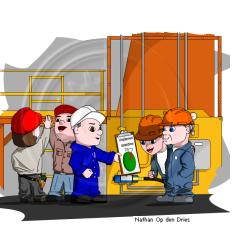Tools and job aids are the levers that amplify human exertion. It's not just about a long handled spanner, to amplify physical exertion, or a torque wrench to make sure that the exertion is accurate. Mental exertion needs help too.
In step 4 - solving the documentation crisis; we looked at the body of information that must be maintained in order to remember lessons learned, and how the machine designer meant for the machine to operate and be maintained.
Ten Step Maintenance Trades Leadership
1. Hire the best tradespersons
2. Develop the team with continuous training and mentorship
3. Provide the best tools and aids
4. Solve the technical documentation crisis
5. Establish a vision and set high expectations
6. Encourage initiative, collaboration, and true craftsmanship
7. Provide regular feedback and assessments
8. Encourage ownership and team autonomy
9. Insist on accountability and team learning
10. Celebrate team successes!
The best tools and aids are items that make it possible for a thoughtful learner to do their very best maintenance work. Why should a passionate mechanic or millwright be expected to set a pressure setting on a hydraulic valve without an accurate pressure test gauge, together with fittings that make it easy to snap in and out of the circuit.
A recent participant at one of our electrical troubleshooting courses admitted that he makes all electrical tests with twenty dollar multimeter.

Many maintenance shops I visit have hydraulic machines with maintenance routines calling for periodic pump testing. This testing is impossible to do without a proper load test, flow meter.
It's much easier for a maintenance department to state and pursue goals of maintenance excellence, to lead and inspire maintenance leadership, when the best tools and aids are made available.
